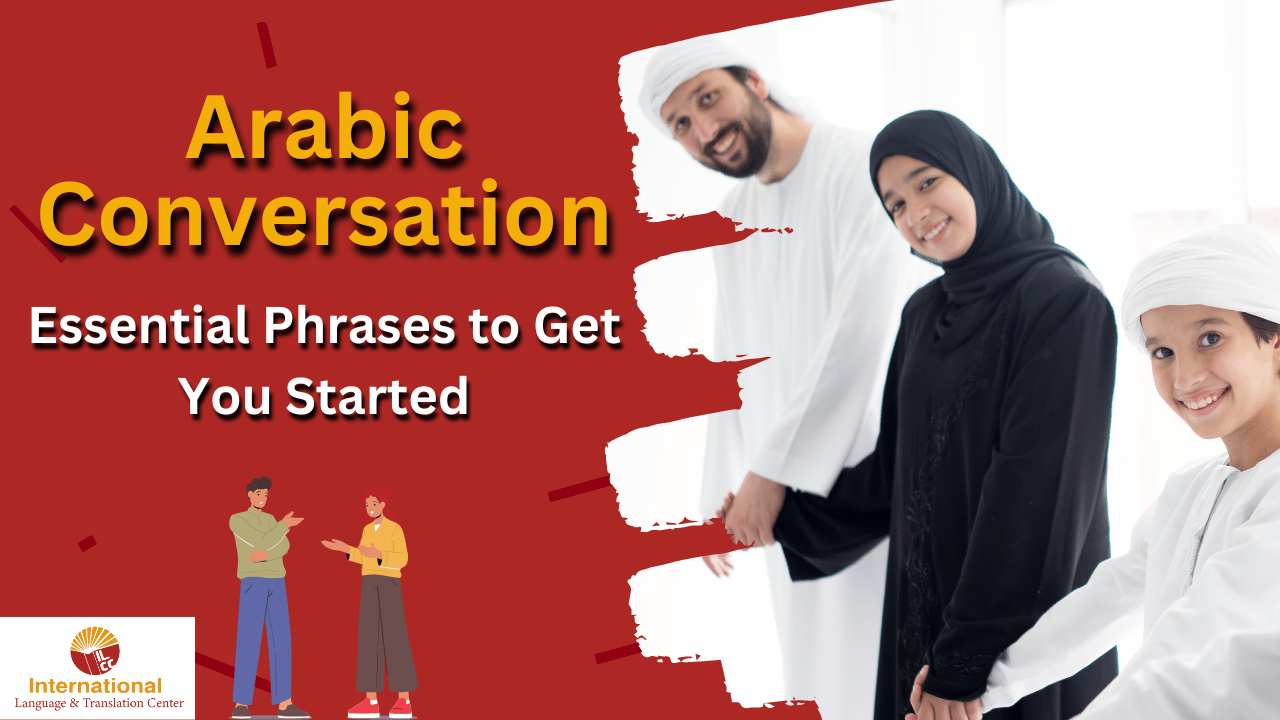Arabic Conversation | Essential Phrases to Get You Started
Arabic, a language of immense historical significance and cultural depth, is spoken by over 400 million people across 22 countries. Its conversation patterns reflect a rich tapestry of traditions, values, and social norms that have evolved over centuries. Engaging in Arabic conversation offers a unique glimpse into the daily lives, thoughts, and emotions of Arabic-speaking communities. From the bustling souks of Marrakech to the serene coffeehouses of Beirut, the art of Arabic dialogue embodies a blend of formal eloquence and colloquial warmth. This article delves into the intricacies of Arabic conversation, highlighting its linguistic features, cultural nuances, and the role it plays in fostering connections and understanding in an increasingly interconnected world. Whether you are a language enthusiast, a traveler, or someone interested in cross-cultural communication, understanding the dynamics of Arabic conversation can open doors to profound and enriching experiences.
The Importance of Learning Conversational Arabic
Learning conversational Arabic offers numerous benefits, making it an invaluable skill in today’s globalized world. Here are some key reasons why mastering Arabic conversation is important:
- Cultural Understanding and Appreciation: Arabic conversation is deeply intertwined with the culture, traditions, and social norms of Arabic-speaking countries. By learning how to converse in Arabic, one gains insights into the values, customs, and everyday life of these communities. This cultural appreciation fosters greater empathy and respect for diverse ways of life.
- Enhanced Communication: With over 400 million native speakers, Arabic is one of the most widely spoken languages in the world. Learning conversational Arabic enables effective communication with Arabic speakers, whether for travel, business, or personal relationships. It bridges language barriers and facilitates more meaningful interactions.
- Professional Opportunities: Proficiency in conversational Arabic opens up a wide range of career opportunities. Many industries, including international business, diplomacy, education, and journalism, value employees who can speak Arabic. It can be a significant asset for roles that require direct communication with Arabic-speaking clients, partners, or colleagues.
- Travel and Tourism: For travelers, knowing conversational Arabic enhances the travel experience by allowing deeper engagement with locals. It enables more authentic experiences, better navigation of local customs, and a greater appreciation of the region’s history and culture.
- Cognitive Benefits: Learning a new language, including conversational Arabic, has cognitive benefits such as improved memory, problem-solving skills, and mental flexibility. It also encourages a more nuanced understanding of one’s native language and its structures.
- Fostering Peace and Mutual Understanding: In a world where misunderstandings and stereotypes often divide cultures, learning conversational Arabic can promote mutual understanding and peace. It breaks down prejudices and fosters dialogue between different cultures, contributing to global harmony.
- Personal Growth and Fulfillment: Mastering a new language like Arabic is a rewarding personal achievement. It challenges individuals to step out of their comfort zones, enhances self-confidence, and provides a sense of accomplishment.
Basics of Arabic conversation
In Arabic conversation, the basics revolve around fundamental linguistic elements and cultural norms essential for effective communication. The exchange typically begins with greetings, where phrases like “As-salamu alaykum” (peace be upon you) are common starters, followed by inquiries about one’s well-being. Introductions ensue, with individuals sharing their names and engaging in polite small talk.
One key aspect of Arabic conversation is the distinction between formal and informal language. This choice depends on various factors like age, social status, and the relationship between speakers. Using the appropriate form of address is crucial in establishing rapport and respect during interactions.
Learning essential phrases and expressions is fundamental to navigating Arabic conversation smoothly. Polite expressions such as “please” (“min fadlak” for males, “min fadlik” for females) and “thank you” (“shukran”) are indispensable. Basic conversational inquiries like “How are you?” (“Kaifa halak” for males, “Kaifa halik” for females) and responses such as “I’m fine, thank you” (“Ana bi-khayr, shukran”) facilitate courteous exchanges.
Politeness and respect are highly valued in Arabic culture, and this is reflected in conversation. Employing honorific titles like “Sheikh” (for an elderly man) or “Sayyida” (for a respected woman) contributes to courteous communication.
Active listening is another crucial aspect of Arabic conversation. Demonstrating interest and understanding through attentive listening enhances the flow of dialogue. Turn-taking is customary, with participants waiting for appropriate pauses to interject or respond.
Non-verbal communication, including facial expressions, gestures, and body language, also plays a significant role in Arabic conversation. Maintaining eye contact and using appropriate hand gestures can convey sincerity and engagement, fostering deeper connections.
Common topics of discussion in Arabic conversation include family, work, weather, and food. Being able to discuss these subjects fluently allows for more meaningful interactions and connections with Arabic speakers.
As conversations draw to a close, parting phrases such as “Ma’a as-salama” (goodbye), “Allah ma’ak” (God be with you), or “Ilalliqa” (until we meet again) are exchanged, ending the interaction on a courteous note.
Mastering these basics of Arabic conversation empowers learners to engage confidently and respectfully in dialogue with Arabic speakers, facilitating cultural understanding and connection-building. Continued practice and exposure to authentic conversations further enhance proficiency and fluency in Arabic communication.
Understand the Arabic language and different dialects
Understanding the Arabic language and its various dialects requires a multifaceted approach due to the language’s rich history, diverse regional variations, and intricate linguistic features. Here’s a guide to help you navigate through:
Mastering Standard Arabic (Modern Standard Arabic or MSA):
Start with learning Modern Standard Arabic (MSA), the standardized form of the language used in literature, media, and formal settings across the Arabic-speaking world.
Resources such as textbooks, online courses, and language learning apps can help you grasp the fundamentals of MSA, including grammar, vocabulary, and pronunciation.
Familiarize Yourself with Regional Dialects:
Understand that Arabic has numerous regional dialects, each with its own unique vocabulary, pronunciation, and grammatical structures.
Choose a specific dialect to focus on based on your interests, travel plans, or personal connections. Popular dialects include Egyptian Arabic, Levantine Arabic (spoken in Lebanon, Syria, Jordan, and Palestine), and Gulf Arabic (spoken in the Arabian Gulf countries).
Expose yourself to authentic materials in your chosen dialect, such as movies, music, and podcasts. Conversing with native speakers or joining language exchange groups can also aid in improving comprehension.
Recognize the Differences:
Be aware that while MSA serves as the lingua franca for formal communication, regional dialects are prevalent in everyday conversation. These dialects may differ significantly from MSA in terms of vocabulary, pronunciation, and grammar.
Pay attention to common features of dialects, such as the use of colloquial expressions, slang, and regional variations in pronunciation and vocabulary.
Practice Listening and Speaking:
Develop your listening skills by regularly exposing yourself to authentic audio recordings or conversations in both MSA and your chosen dialect. This could include listening to news broadcasts, watching TV shows or movies, and engaging in conversations with native speakers.
Practice speaking by actively participating in conversations, whether through language exchange partners, language classes, or online forums. Don’t be afraid to make mistakes, as they are an essential part of the learning process.
Study Grammar and Vocabulary in Context:
Study grammar and vocabulary in the context of real-life situations and conversations. Understand how words and phrases are used in different dialects and practice incorporating them into your speech.
Use language learning resources that focus specifically on the dialect you’re learning, as they often provide explanations and examples tailored to regional variations.
Be Patient and Persistent:
Learning Arabic and its dialects can be challenging, but persistence and patience are key. Set realistic goals, stay motivated, and celebrate your progress along the way.
Embrace the cultural richness and diversity of the Arabic-speaking world as you journey through the language, and enjoy the process of learning and discovery.
By following these steps and immersing yourself in the language and culture, you can gradually develop a deeper understanding of Arabic and its various dialects, enriching your linguistic repertoire and cultural appreciation.
Tips for learning Arabic conversation
Learning Arabic conversation can be both rewarding and challenging, especially for beginners. To start, focus on mastering the basics. Learn common greetings, introductions, and essential phrases. These foundational elements will provide you with a solid framework for engaging in Arabic conversation. Pronunciation is particularly important in Arabic, as the sounds can be quite different from other languages. Spend time practicing speaking aloud and listening to native speakers to improve your pronunciation skills.
Consistent practice is key to improving your Arabic conversation skills. Set aside time each day to engage in conversation, whether it’s with a language partner, tutor, or through language exchange platforms. Immersing yourself in Arabic language and culture will also greatly aid your learning process. Watch Arabic TV shows and movies, listen to Arabic music and podcasts, and read Arabic books and newspapers to become more familiar with the language and improve your comprehension skills.
Language learning apps and online resources can be valuable tools for learning Arabic conversation. Apps like Duolingo, Rosetta Stone, and Babbel offer interactive lessons and exercises to help you practice speaking and listening skills. Finding a language partner or tutor can provide personalized feedback and guidance, helping you improve your fluency and confidence in Arabic conversation.
Listening is an essential aspect of language learning, so focus on developing your listening skills. Spend time listening to Arabic conversations, whether it’s through podcasts, audio recordings, or conversations with native speakers. Pay attention to pronunciation, intonation, and common phrases used in everyday conversation. Additionally, be patient and persistent in your learning journey. Learning a new language takes time and effort, so celebrate your progress along the way and don’t be afraid to make mistakes – they’re a natural part of the learning process.
Finally, remember to practice cultural sensitivity. Take the time to understand the cultural context in which Arabic conversation takes place and respect cultural norms and customs. By following these tips and staying dedicated to your learning journey, you’ll be well on your way to mastering Arabic conversation.
Or you can contact us at Ilcc
ILCC
Discover the world of languages and translation with us!
Join us and explore the world of languages and translation with the highest quality and professionalism! On our website, we offer you a unique and distinctive learning experience that allows you to acquire new language skills with ease and enjoyment.
Our center is distinguished by a team of qualified and specialized language teachers who ensure that they provide personal and effective lessons that perfectly meet your needs. Whether you want to learn a new language or improve your current level, we are here to help you achieve your goals smoothly and effectively.
In addition, our website provides accurate and professional translation services, where our team works to provide high-quality and reliable translations in various fields. Whether you need to translate official documents, marketing content, or scientific articles, you can rely on us to provide translation services with the highest standards of quality and accuracy.
On our website, we combine comprehensive language education and distinguished translation services to provide you with a unique and distinctive learning experience. Join us now and start your journey in the world of languages and translation with confidence and determination.
You can contact us on WhatsApp from here → ILCC.
Conclusion
In the tapestry of global languages, Arabic stands out as a vibrant thread, weaving together rich traditions, diverse cultures, and profound histories. Throughout this exploration of Arabic conversation, we have delved into its intricate nuances, from the graceful cadence of greetings to the lively exchanges of everyday dialogue.
Arabic conversation is not merely a linguistic exercise; it is a gateway to understanding and connecting with the hearts and minds of Arabic-speaking communities. It opens doors to cultural enrichment, professional opportunities, and personal growth.
As we journeyed through the basics of Arabic conversation, from mastering greetings to navigating regional dialects, we discovered the importance of patience, persistence, and cultural sensitivity. Learning Arabic conversation is not without its challenges, but the rewards are boundless – from forging new friendships to fostering mutual understanding in an increasingly interconnected world.
In embracing the art of Arabic conversation, we embrace more than just words; we embrace a celebration of diversity, a bridge of communication, and a testament to the beauty of human connection. So let us continue to engage, to listen, and to learn, as we embark on a journey of discovery through the captivating realm of Arabic conversation. Ma’a as-salama (goodbye), until we meet again.









